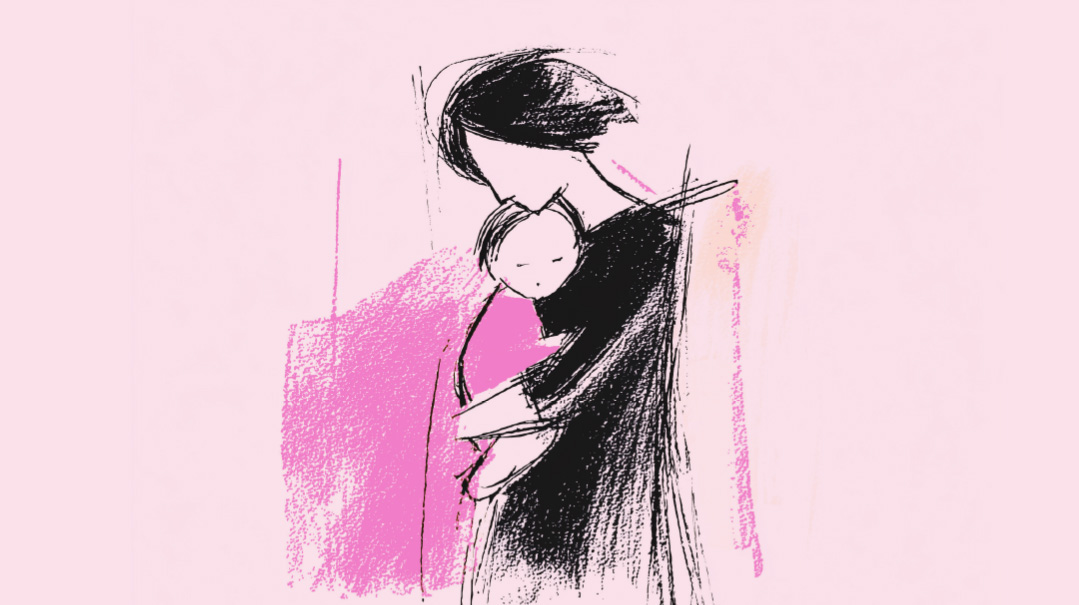Faith and Fortitude

Crushing loss didn’t break Mrs. Shifra Hayman, it only made her more determined to maximize every moment

When I open my front door in the morning, the very first thing I see is a sign that reads, “Hayman.” Every day, on my way home, I’d see Mrs. Shifra Hayman sitting with a different woman from the community in her beautiful garden. Every day I told myself that I, too, wanted to get to know Mrs. Hayman.
I understood she wasn’t up to talking much anymore, but I noticed how every visitor would bask in delight. It piqued my curiosity.
I never knocked on that door, so I never got to know this special woman. She passed away four days before Yom Kippur at the age of 75. I resolved to find out what drew so many people to her.
For the first seven years of her life, Shirlee Rose Gassman (as she was known then) lived in Chicago. Her family moved to an Indian reservation, and then again to San Diego.
She attended UCLA, where she earned a bachelor’s degree in French, but as she grew in her Yiddishkeit, she became increasingly disappointed by how much anti-Semitism pervaded French literature. She wanted to concentrate on growing her religious observance, so she rejected a scholarship to learn in Bordeaux, went back to school, and got a master’s in social work.
After she met and married her husband, Eliyahu Dovid (then Alan), the two of them embarked on a journey together to learn more about Judaism. They attended a shiur given by a rotation of rabbis, one of whom was Rav Simcha Wasserman ztz”l. They joined a Conservative temple, first participating in the weekly service, then kashering their home.
The couple moved to the San Fernando Valley, a suburb of Los Angeles, and got permission from the Conservative temple rabbi to run an Orthodox minyan in a classroom inside the building. They built a mechitzah and handed out Birnbaum siddurim (one of which had been a wedding gift from Rav Wasserman).
But just as they were building up the minyan, the temple installed an alarm that wasn't permissible for Shabbos use. Mr. Hayman removed the mechitzah and siddurim, returned his key, and that was the end of the minyan. The Haymans realized there weren’t enough people in their L.A. suburb to support an Orthodox minyan.
They began to spend Shabbos in YULA (Yeshiva University of L.A.). By then, their only daughter, Shoshana, was ten years old. The three of them would all happily sleep on mattresses on the floor in an office in the yeshivah. They kashered their kitchen again, this time fully in accordance with halachah.
After two years of commuting back and forth to YULA, they moved to the Pico-Robertson neighborhood of L.A. They also got remarried (after Mr. Hayman had a pidyon haben), with kosher eidim. When they learned about glatt kosher, they kashered their kitchen a third time. They became well known for having many guests, especially yeshivah bochurim.
Fifteen years later, a simchah on the other side of town led them to the shul of Rabbi Gershon Bess. After being exposed to the structure, davening, and learning in Rabbi Bess’s shul, they wanted to be a part of it. After Friday night davening, Mr. Hayman turned to his wife and said, “Time to move!” Mrs. Hayman fully agreed.
There were no giant leaps in their level of Jewish observance. It was a gradual metamorphosis from Conservative to Modern Orthodox to chareidi. They never lost sight of their goal: growing in ruchniyus, one small step at a time.
Mr. Hayman describes their side-by-side growth: “It’s like when a person walks. First one foot is in front, then the other foot is in front. Sometimes she’d be a little further along than I was, and sometimes I’d be ahead.”
Chesed was an integral part of Mrs. Hayman’s life. “During the shivah,” Mr. Hayman told me, “I heard so many stories about her chesed, so many things I had no idea she was doing.
“My wife had her trademark chasadim and included me in them. When I’d be out shopping, she asked me to stop in the toy store, and buy a few boxes of Clics so we’d always have a gift for siblings at a bris. She didn’t just help out, she intuited what was needed.
“There was a family we knew where the father traveled frequently. She sent me to their house with a 100-shekel bill saying, ‘Pizza gemach! It’s pizza night, because Abba is away.’”
No Complaints
No matter what life brought, Mrs. Hayman used the experience to strengthen her emunah. After Shoshana finished seminary, she returned to L.A. When there were few suitable shidduchim prospects, she moved to New York. Though she didn’t want to be separated from her only child, Mrs. Hayman encouraged the move for her daughter’s sake.
In New York, Shoshana became a highly respected elementary school teacher. After she got married, she was accepted into a program for mechanchim to get a master’s degree in Jewish education. The course included weekly classes in Yeshiva University in New York, followed by six weeks in the Grus Kollel in Israel.
On the last day of class in Israel, she stepped into a Sbarro pizza shop to get lunch for a friend. She was there less than five minutes when a suicide bomber blew himself up, taking Shoshana and 14 other people with him. She’d been expecting her first child.
When the Haymans heard about the bombing, they called Shoshana but could not reach her. Then they learned that Mr. Hayman’s brothers were asked to identify her body. Finally, they were told she was positively identified as one of the martyrs. Mrs. Hayman said, “We didn’t complain when she was born,” she said, “so we’re not complaining now. We had her for 31 years.”
Mr. Hayman still speaks of her faith with awe. “Our only child,” he said, “she was our only child. And she wasn’t just our only child, she was a legendary mechaneches. In her 12 years in chinuch, she’d taught over 500 girls.” The many letters Shoshana received were a source of chizuk to both her parents, and helped them get through that difficult era.
Mrs. Hayman grieved, but her solid trust in Hashem never wavered. Her daughter’s death didn’t deter her from making aliyah. Moving to Eretz Yisrael was a value, and it remained so despite the tragedy that had occurred there.
During a two-week trip to Israel, the Haymans stayed in Ramat Beit Shemesh. Mrs. Hayman was so thrilled to have a local makolet that she shopped there two or three times a day just to relish the experience; it was a concrete realization that she was actually in Eretz Yisrael, something she’d dreamed of for a long time.
After a week and a half davening in the Gra shul, and having met Rabbi Elimelech and Rebbetzin Naomi Kornfeld, they were hooked. Once again, Mr. Hayman said, “It’s time,” and Mrs. Hayman immediately agreed.
They called a real estate agent about an apartment and within a few hours, they had purchased their home in Eretz Yisrael. They flew back home to L.A.; the next morning, after Shacharis, Mr. Hayman told a shul member that they’d signed on an apartment in Ramat Beit Shemesh. On the spot the man offered to buy their house.
Open House
What Mrs. Hayman loved about the apartment was its size. Since Shoshana had passed away three years earlier, it was just the two of them. Mrs. Hayman’s dream was to host seminary girls, so they bought an apartment big enough to accommodate girls — lots of them.
Before leaving the US, they shopped for furnishings that would make seminary girls feel at home: good quality beds, American furniture. As soon as they got settled, Mrs. Hayman called two seminaries and asked to be on their out-Shabbos list. Within two weeks, the word was out: the Haymans’ is the place to go!
For six years they hosted between six and nine seminary girls nearly every week. They were booked weeks in advance.
There was one other thing the Haymans checked out before buying their apartment — how close it was to the Gra shul. Mrs. Hayman accompanied her husband to shul every Shabbos, continuing her L.A. traditions: greeting newcomers, handing them a Chumash and a siddur, then following up with a Shabbos invitation and a welcome package for their freezer.
After 12 years, on a visit to the US, a car accident disabled both Mr. and Mrs. Hayman. The physical recovery was grueling; it took six weeks before they were well enough to return home. Again, Mrs. Hayman didn’t complain. When she was well enough to go to shul but not to manage the long walk from their home, they relocated to an apartment much closer to the shul.
From Los Angeles to Ramat Beit Shemesh and everywhere she visited even briefly, Mrs. Shifra Hayman will always be looked up to as a paragon of faith and fortitude in the face of personal and national tragedy
A suggestion was made to dedicate a new local park to Shoshana’s memory. Surprisingly, the Haymans rejected the proposal. “Why would our daughter’s petirah take precedence over anyone else’s personal tragedy?” Mrs. Hayman said. “Who’s to say there aren’t others who suffer more or deserve the recognition more?”
They finally relented, with two caveats: First, if at any future point someone would object to the dedication, the memorial stone would be removed without further consideration; alternatively, other names could be added. Second, the words “Hashem yikom damah — Hashem should avenge her blood” shouldn’t be written on the plaque. Because this was a park for children to play and be light and carefree, they didn’t want any mention of blood.
—Malky Newman
Mrs. Hayman was a special woman. A tzadeikes. Everybody’s family was her family; everybody’s kids were her kids. She loved children — listening to the way they talked, watching how they played. She kept toys in her house, and kids loved to be with her.
She was thankful for every little thing. She kept a collection of thank-you cards so she’d always be able to show appreciation, even to a child who’d given her a simple drawing. When her hand became too shaky to write, she’d ask someone else to write the cards. She loved her birthdays — they were an opportunity to bless people.
With all her yissurim, she never complained! During the last month of her life, she could barely speak, but she managed to say thank you with a huge smile. She just wanted people to feel good, her non-Jewish aides included.
Once when I visited, she needed something, and I told her to ask her aide. “I won’t disturb her now,” she said. “She’s also a person, she needs time and space for herself.”
She called me once to say she had a freezer full of food, did I know of a family that might need something for Yom Tov? She was going away and was afraid there might be a power outage, and the food might spoil. I knew the truth! She’d cooked the food ahead of time in order to give it away. She was so tzanuah that she didn’t want anyone to know how much she was giving.
—Rebbetzin Naomi Kornfeld,
Kehillas Hagra shul, RBS
At my first son’s bris, Mrs. Hayman introduced herself and handed me a present. When she looked at the baby she said, “My, he’s big!” the next day, she sent another outfit, one size bigger.
Over time, the Haymans joined us for five more brissim. Mrs. Hayman always came with a present, plus gifts for my other kids so they shouldn’t feel left out.
When my seventh was a newborn, Mrs. Hayman was sitting shivah for her mother. I went to be menachem avel, and she immediately turned to me.
“Mazel Tov! I’m so happy for you, I wanted to call. How’s your princess?” Even during shivah, she remembered that after six boys, I’d finally had a girl. She couldn’t help but share in my simchah.
—Shoshi Ross
I first met Mrs. Hayman in a kitchen store. I could hardly see past the pain of my recent separation, waiting for my get, and dealing with my kids; she was all smiles, excited to be planning her new home in Israel. She told me her daughter would’ve been better at kitchen planning. Imagine my surprise when I learned who her daughter was.
When she learned that my oldest daughter is named Shoshana, she gave me a gorgeous mirror with the name Shoshana painted on it, and some other personalized items. She was thrilled they’d be used instead of sitting in storage.
One day, while stressed about not having interim storage space during an upcoming move, I ran into Mrs. Hayman. “This morning I had a hard time getting out of bed,” she told me. “But there was some reason I had to get up and walk to shul! You can store your things in our basement. Now you have one less thing to worry about.”
The storage problem resolved itself, and when I told her I wouldn’t need her basement she said, “I knew Hashem would take care of it for you!” These small, simple messages that she said so casually, but with such strong belief that Hashem was watching out for us, strengthened me immensely.
Over the years Mrs. Hayman continually gave me strength, taught me more about emunah than any book could have, and became someone I could trust, cry to, and smile with. She celebrated our simchahs with such joy, bought my kids small gifts of encouragement before their big tests, and always gave them a huge smile whenever she saw them — on the street, in the park, or when they knocked on her door to ask if they could play with the toys.
Everyone was greeted with that famous Mrs. Hayman smile and her “HELLO!” which was always said with so much joy and enthusiasm. Each person felt like they were the most important person in the world to her. And they were.
—Liba Rosenthal
At my son’s wedding, what did Mrs. Hayman hand me? A mini-packet of tissues. We’d lost our other son, and she knew it’d be a hard wedding for us. I understood the meaning: You’ll cry; you’ll need these tissues. When the mini-pack is gone, be happy with everybody else. I received both her caring and her important message.
—Anonymous
My Yamim Noraim seat was next to Mrs. Hayman’s. My mother had young children and didn’t buy a seat for herself. Still, she’d come several times and stay a few minutes. Every time, Mrs. Hayman moved to the back of the ezras nashim so my mother and I could daven next to each other.
My mother insisted there was no need, she was there only for a few minutes, and she stands for the davening. Mrs. Hayman said, “If my daughter were here, I would’ve wanted to daven next to her.”
—YS Glick
(Originally featured in Family First, Issue 763)
Oops! We could not locate your form.







